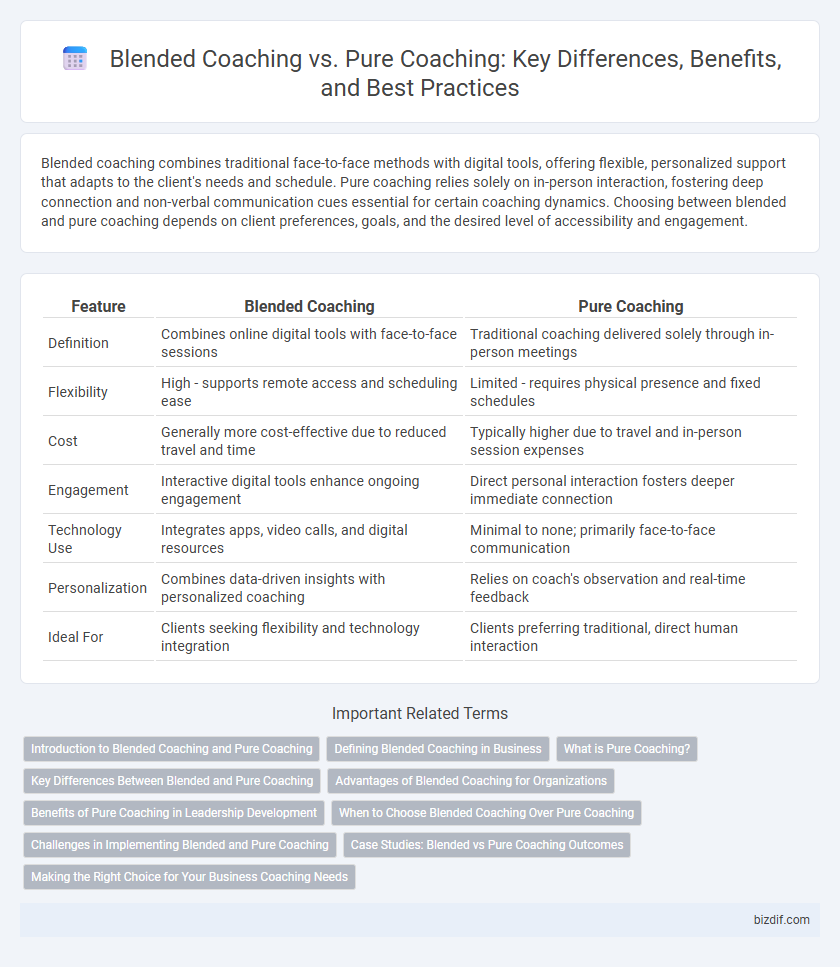Blended coaching combines traditional face-to-face methods with digital tools, offering flexible, personalized support that adapts to the client's needs and schedule. Pure coaching relies solely on in-person interaction, fostering deep connection and non-verbal communication cues essential for certain coaching dynamics. Choosing between blended and pure coaching depends on client preferences, goals, and the desired level of accessibility and engagement.
Table of Comparison
| Feature | Blended Coaching | Pure Coaching |
|---|---|---|
| Definition | Combines online digital tools with face-to-face sessions | Traditional coaching delivered solely through in-person meetings |
| Flexibility | High - supports remote access and scheduling ease | Limited - requires physical presence and fixed schedules |
| Cost | Generally more cost-effective due to reduced travel and time | Typically higher due to travel and in-person session expenses |
| Engagement | Interactive digital tools enhance ongoing engagement | Direct personal interaction fosters deeper immediate connection |
| Technology Use | Integrates apps, video calls, and digital resources | Minimal to none; primarily face-to-face communication |
| Personalization | Combines data-driven insights with personalized coaching | Relies on coach's observation and real-time feedback |
| Ideal For | Clients seeking flexibility and technology integration | Clients preferring traditional, direct human interaction |
Introduction to Blended Coaching and Pure Coaching
Blended Coaching integrates face-to-face sessions with digital tools, enabling personalized learning experiences and flexible interaction between coach and client. Pure Coaching involves exclusively in-person or synchronous virtual sessions, emphasizing direct human connection and real-time feedback. Understanding the distinctions allows organizations and individuals to choose the optimal coaching method for their developmental goals and resource availability.
Defining Blended Coaching in Business
Blended coaching in business integrates traditional face-to-face coaching with digital tools such as video conferencing, online assessments, and e-learning platforms to enhance flexibility and accessibility. This hybrid approach leverages real-time interaction and asynchronous resources, enabling personalized development while optimizing time and cost efficiency for organizations. Compared to pure coaching, which relies solely on direct personal engagement, blended coaching facilitates continuous learning and scalable support aligned with dynamic business needs.
What is Pure Coaching?
Pure coaching is a personalized, one-on-one process focused exclusively on the client's goals, challenges, and development without integrating external tools or methodologies. It emphasizes active listening, powerful questioning, and reflective feedback to unlock the client's potential and promote self-discovery. This approach maintains confidentiality and fosters a trusting relationship that drives authentic progress and sustainable change.
Key Differences Between Blended and Pure Coaching
Blended coaching integrates both in-person and digital coaching methods, enabling personalized flexibility and access to resources, whereas pure coaching relies exclusively on face-to-face interactions, emphasizing direct communication and immediate feedback. The key differences lie in delivery format, engagement style, and adaptability, with blended coaching offering a hybrid approach that enhances scalability and convenience. Pure coaching typically fosters deeper interpersonal connections and accountability through consistent, real-time presence.
Advantages of Blended Coaching for Organizations
Blended coaching integrates both digital tools and face-to-face interaction, enhancing organizational flexibility and scalability in employee development. This hybrid approach allows for personalized learning experiences while optimizing resource allocation and reducing costs. Organizations benefit from improved engagement and measurable progress, fostering a culture of continuous improvement and adaptability.
Benefits of Pure Coaching in Leadership Development
Pure coaching in leadership development offers unparalleled personalized guidance, fostering deep self-awareness and authentic growth. This focused approach eliminates distractions from digital tools, ensuring leaders engage fully in reflective conversations that enhance emotional intelligence, decision-making, and strategic thinking. Such tailored, human-centric interaction accelerates behavioral change and sustains long-term leadership effectiveness.
When to Choose Blended Coaching Over Pure Coaching
Blended coaching offers a flexible approach combining in-person sessions with digital tools, ideal for clients seeking personalized support alongside self-paced learning. Choose blended coaching when addressing complex development goals that benefit from real-time interaction and continuous online resources. This method enhances engagement and accountability, especially in remote or hybrid work environments where availability and accessibility vary.
Challenges in Implementing Blended and Pure Coaching
Implementing blended coaching faces challenges such as coordinating technology integration with personalized coaching methods and ensuring consistent engagement across digital and face-to-face platforms. Pure coaching encounters difficulties in scalability and lack of flexibility, often limiting access for remote or time-constrained clients. Both approaches must address issues related to maintaining coaching quality and adapting to diverse learner needs effectively.
Case Studies: Blended vs Pure Coaching Outcomes
Case studies reveal that blended coaching, combining in-person and digital sessions, enhances client engagement and measurable progress compared to pure coaching, which relies solely on face-to-face interaction. Data from multiple organizations indicate a 30% higher retention rate and faster goal achievement in blended coaching programs. These findings highlight the effectiveness of integrating technology with traditional coaching methods for optimized outcomes.
Making the Right Choice for Your Business Coaching Needs
Blended coaching combines in-person and virtual sessions to offer flexibility and personalized interaction, while pure coaching typically relies exclusively on one method, often virtual, for convenience and scalability. Businesses seeking tailored engagement and adaptive learning environments benefit from blended coaching, which fosters deeper client-coach relationships and better retention. Evaluating factors like budget, client preferences, and training goals helps determine the optimal coaching format to maximize ROI and employee development.
Blended Coaching vs Pure Coaching Infographic

 bizdif.com
bizdif.com